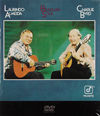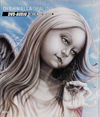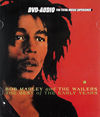Come Together Page 2
My ears prick up when Hurley mentions that he's about to get his hands on test pressings of Jackson Browne's Running on Empty DVD-Audio. The 1977 release was a rather unusual live recording; it combined concert tracks with tunes recorded in hotel rooms and on the tour bus. Hurley encouraged me to give Browne's producer/engineer, Greg Ladanyi, a call.
 The man has had a decades-long working relationship with Browne, and I was curious about what sort of feedback he got from him about the 5.1 mix.
The man has had a decades-long working relationship with Browne, and I was curious about what sort of feedback he got from him about the 5.1 mix.
"He wanted reality. There were a couple of times when I went too far embellishing the surrounds, and he brought it back. Jackson wanted to minimize the special effects and reverb—go intimate, like the way it really sounded in the room."
"That's great, but beyond the obvious spatial advantages, what does 5.1 bring to the party?"
"I'm trying to bring the songs closer to the listener," said Ladanyi. I think you can get closer to the production values through a 5.1 mix. You can hear atmospheres in 5.1 that get lost in stereo. You really have to work to make 60 tracks of music fit into just two. You might have to take some bottom out of some instruments, add a lot of compression, and EQ to make sure everything is in balance. When you disperse the same music over 5.1 speakers, the music has more space to be alive in. It's a tremendous difference."
"Right, and I've noticed bass definition gets a big boost in 5.1."
 Ladanyi is on a roll: "Remember, guitars and keyboards' bass harmonics can cover up bass instruments. By separating those instruments in the surround mix, bass clarity goes way up. Sometimes I'll move instruments around in the 5.1 mix just until the bass gets more defined."
Ladanyi is on a roll: "Remember, guitars and keyboards' bass harmonics can cover up bass instruments. By separating those instruments in the surround mix, bass clarity goes way up. Sometimes I'll move instruments around in the 5.1 mix just until the bass gets more defined."
"Speaking of definition, what are your thoughts on mixing for the center speaker?"
"Imagine mixing Crosby, Stills & Nash and giving each one his own speaker—left, center, and right—so you can almost see each vocal in each speaker. Their harmony parts are more-easily heard. In stereo, you get a wash of blends."
Master of the DVD-Audio Universe
I trust mastering engineers' ears above all others, so I next turned to the best, Bob Ludwig, to get to the heart of the matter. "Other than the obvious surround-versus-stereo differences, Bob, how would you describe DVD-Audio's sonic superiority over CD?"
 Bob wasted no time setting me straight: "First a caveat: It is easily possible to play a CD through an $8,000 professional digital-to-analog converter and have it sound better—much better—than a DVD-Audio player equipped with the usual $5 Walkman-quality converters. Having said that, if the CD/DVD-Audio players' converters are of equal quality, the first thing DVD-Audios have over CDs is the ability to reproduce the full 24-bit dynamic range, and that greatly enhances the soundstage, lowers distortion, and improves the resolution of echo trails. Moving CD players' easy-to-hear anti-aliasing filter's presence up an octave to 96 kilohertz (or up to 192 kHz) creates an analog-sounding top end with no harshness or brittleness. It's round and true, like the source. Hearing a DVD-Audio played over professional converters is an extreme treat!"
Bob wasted no time setting me straight: "First a caveat: It is easily possible to play a CD through an $8,000 professional digital-to-analog converter and have it sound better—much better—than a DVD-Audio player equipped with the usual $5 Walkman-quality converters. Having said that, if the CD/DVD-Audio players' converters are of equal quality, the first thing DVD-Audios have over CDs is the ability to reproduce the full 24-bit dynamic range, and that greatly enhances the soundstage, lowers distortion, and improves the resolution of echo trails. Moving CD players' easy-to-hear anti-aliasing filter's presence up an octave to 96 kilohertz (or up to 192 kHz) creates an analog-sounding top end with no harshness or brittleness. It's round and true, like the source. Hearing a DVD-Audio played over professional converters is an extreme treat!"
"Sounds like fun, but can we really expect to hear the format's prodigious dynamic range potential, or are the producers still demanding maximum dynamic range compression?"
Ludwig patiently handles my loaded query: "It depends. Some of the groups I've worked with, like Linkin Park, Foo Fighters, or Nine Inch Nails, require a lot of compression—it's a part of their sound. So it really depends on the music. On Sting's Brand New Day, there's a vast difference between Elliot Scheiner's 5.1 mix and the stereo CD. I almost can't listen to the CD—it's so compressed, so un-Sting. The 5.1 makes me smile."
 "Ah, Bob, you're a true believer. Do you handle analog and digital recordings differently?"
"Ah, Bob, you're a true believer. Do you handle analog and digital recordings differently?"
"Yes, but 99 percent of all surround recordings we do are digital, and they're almost always 24-bit, which makes a big difference to me. The extra bits eliminate most of the worst digital nasties."
"But isn't there something of an analog renaissance going on?"
"Lately, one of the best surround mixers has gone back to analog. He sends us his mixes on 2-inch analog tape, and they sound awesome!"
"I'm almost afraid to bring up this rather touchy subject, but what about bass management? That's the province of the mix engineer, right?"
"Unfortunately, not usually. For some reason, most of those million-dollar consoles don't have a low-pass filter for keeping the .1 channel limited to 80 to 120 Hz."
"Of the newer titles you've mastered, do you have any favorites?"
"Donald Fagen's Nightfly should be out soon. It's a killer! I also did Miles Davis' Tutu, which really sounds spectacular!"





















































